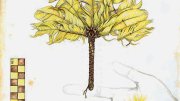In Scale & the Incas (Princeton University Press, $65), Andrew James Hamilton, Ph.D. ’14, examines the role of size—manifest in tiny conopas (hand-held idols) and massive stonework—in the art of this vanished South American civilization. Scale, he argues, undergirded Inca thought. It was how they conceptualized key relationships: between life on earth and celestial constellations; the emperor and the sun; far-flung populations and the capital. Color plates, which the author hand-drew in pencil, watercolor, and gouache, illustrate his narrative with lush precision.
A Getty/ACLS Fellow who will become associate curator of art of the Americas at the Art Institute of Chicago this spring, Hamilton begins the book with this enigma of anthropology:
The storerooms of the Harvard Peabody Museum are filled with towering totem poles and tent posts, elongated dugout and birch bark canoes, and massive casts of stelae. The collection is at once a sprawling repository of art and industry and a microcosmic encapsulation of it because of the teaching museum’s vast size relative to other institutions and the staggering quantity of objects humans have produced. Amid this panoply of evidence of the ways civilizations have thought and wrought, strived and thrived, a clutch of diminutive Andean artifacts raises outsized questions about the ways societies conceptualize, perceive, and interpret scale.
Because the objects are so small—only a few centimeters long—curators have augmented their size. They have been grouped together, nestled into foam supports, and placed inside larger boxes. Removing a gray-blue lid, many of the contents may look like silver-colored wires, perhaps sewing needles… The two dozen burnished objects present unusably small versions of ancient Andean tools for spinning and weaving. There is even an intricate loom featuring a repoussé-chased textile. Although the shapes of the original implements were ergonomically developed to be manipulated by hands, these smaller, denser objects forge new relationships with human bodies. Holding any of these minutely crafted but seemingly useless tools, it is hard not to wonder: what were their makers thinking?
Indeed, the logic or function of these objects is unclear. They were purchased from a dealer in Lima in 1947 with no documentation of where they came from or how they were found. They can be loosely attributed to the north coast of Peru after the year 1000, because of the iconography on the metal weaving. When the enigmatic cache arrived at the Peabody Museum in 1948, the registrar who accessioned them had to decide what to officially call them. With little evidence to analyze beyond their physical forms, they were dubbed a “child’s silver toy loom and parts thereof.” Because their scale meant they could not function as actual tools, the most plausible explanation—at least to a modern viewer—was that they were pretend or make-believe tools reduced in scale to fit a child’s hands. What is critical to understand about this classification, however, is that other toys and things broadly consistent with modern Euro-American notions of childhood are not common in the Andean archaeological record, let alone ones made of valuable silver. This would-be rationalization was perhaps as illogical as the objects’ scale in the first place. And yet, in spite of this contradiction, many remain labeled this way.
The fundamental significance of this episode—simple as it may be—is that the scale of an object communicated something to a viewer. Moreover, it potentially communicated different things to different viewers based on their cultural backgrounds. The thousand-year-old message that the registrar believed was successfully received was more likely something lost in translation.









